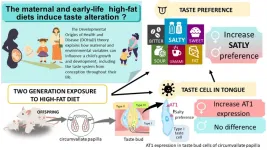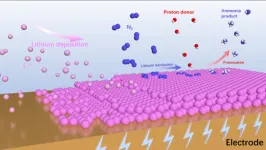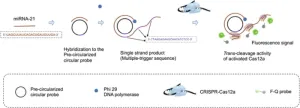(Press-News.org) CORVALLIS, Ore. – During the last ice age, massive icebergs periodically broke off from an ice sheet covering a large swath of North America and discharged rapidly melting ice into the North Atlantic Ocean around Greenland, triggering abrupt climate change impacts across the globe.
These sudden episodes, called Heinrich Events, occurred between 16,000 and 60,000 years ago. They altered the circulation of the world’s oceans, spurring cooling in the North Atlantic and impacting monsoon rainfall around the world.
But little was known about the events’ effect on nearby Greenland, which is thought to be very sensitive to events in the North Atlantic. A new study from Oregon State University researchers, just published in the journal Nature, provides a definitive answer.
“It turns out, nothing happened in Greenland. The temperature just stayed the same,” said the study’s lead author, Kaden Martin, a fourth-year doctoral candidate in OSU’s College of Earth, Ocean, and Atmospheric Sciences. “They had front-row seats to this action but didn’t see the show.”
Instead, the researchers found that these Heinrich events caused rapid warming in Antarctica, at the other end of the globe.
The researchers anticipated Greenland, in close proximity to the ice sheet, would have experienced some kind of cooling. To find that these Heinrich Events had no discernible impact on temperatures in Greenland is surprising and could have repercussions for scientists’ understanding of past climate dynamics, said study co-author Christo Buizert, an assistant professor in the College of Earth, Ocean, and Atmospheric Sciences.
“If anything, our findings raise more questions than answers,” said Buizert, a climate change specialist who uses ice cores from Greenland and Antarctica to reconstruct and understand the Earth’s climate history. “This really changes how we look at these massive events in the North Atlantic. It’s puzzling that far-flung Antarctica responds more strongly than nearby Greenland.”
Scientists drill and preserve ice cores to study past climate history through analysis of the dust and tiny air bubbles that have been trapped in the ice over time. Ice cores from Greenland and Antarctica provide important records of Earth’s atmospheric changes over hundreds of thousands of years.
Records from ice cores from those regions have served as pillars for scientists’ understanding of past climate events, with ice collected from both locations often telling similar stories, Martin said.
The impact of Heinrich Events on Greenland and Antarctica was not well understood, spurring Martin and Buizert to try to find out more about what was happening in those parts of the world.
The core used for the latest study was collected in 1992 from the highest point of Greenland, where the ice sheet is around 2 miles thick. Since then, the core has been in storage in the National Science Foundation Ice Core Facility in Denver.
Advancement in scientific tools and measurements over the last few decades gave Martin, Buizert and their colleagues the opportunity to re-examine the core using new methods.
The analysis shows that no changes in temperatures occurred in Greenland during Heinrich Events. But it also provides a very clear connection between Heinrich Events and the Antarctic response.
“When these big iceberg discharges happen in the Arctic, we now know that Antarctica responds right away,” Buizert said. “What happens in one part of the world has an effect on the rest of the world. This inter-hemispheric connection is likely caused by change in global wind patterns.”
The finding challenges the current understanding of global climate dynamics during these massive events and raises new questions for researchers, Buizert said. The researchers’ next step is to take the new information and run it through climate models to see if the models can replicate what occurred.
“There has to be a story that fits all of the evidence, something that connects all the dots,” he said. “Our discovery adds two new dots; it’s not the full story, and it may not be the main story. It is possible that the Pacific Ocean plays an important role that we haven’t figured out yet.”
The ultimate goal is to better understand how the climate system is connected and how the components all interact, the researchers said.
“While Heinrich Events are not going to happen in the future, abrupt changes in the globally interconnected climate system will happen again,” Martin said. “Understanding the global dynamics of the climate system can help us better project future impacts and inform how we respond and adapt.”
Additional co-authors are Ed Brook, Jon Edwards, Michael Kalk and Ben Riddell-Young of OSU; Ross Beaudette and Jeffrey Severinghaus of the Scripps Institution of Oceanography; and Todd Sowers of Pennsylvania State University.
The research was supported by the National Science Foundation, the Global Climate Change Foundation and the Gary Comer Science and Education Foundation.
END
Massive iceberg discharges during the last ice age had no impact on nearby Greenland, raising new questions about climate dynamics
2023-04-24
ELSE PRESS RELEASES FROM THIS DATE:
New biologic effective against major infection in early tests
2023-04-24
Researchers at NYU Grossman School of Medicine and Janssen Biotech, Inc. have shown in early tests that a bioengineered drug candidate can counter infection with Staphylococcus aureus – a bacterial species widely resistant to antibiotics and a major cause of death in hospitalized patients.
Experiments demonstrated that SM1B74, an antibacterial biologic agent, was superior to a standard antibiotic drug at treating mice infected with S. aureus, including its treatment-resistant form known as MRSA.
Published ...
Researchers develop new tools for precise large DNA insertions
2023-04-24
GAO Caixia's group from the Institute of Genetics and Developmental Biology of the Chinese Academy of Sciences (CAS) has developed a new genome editing technology that achieves efficient and precise targeted insertion of large DNA segments in plants.
The new technology, called prime editing-mediated recombination of opportune targets (PrimeRoot), combines an optimized dual-ePPE editor protein previously published by the group with a highly efficient tyrosine site-specific recombinase, Cre. It can achieve ...
Researchers ID novel treatment pathway for deadly pancreatic cancers
2023-04-24
Researchers at the Johns Hopkins Kimmel Cancer Center identified a novel cell signaling pathway that potentially could be targeted in therapy for patients with aggressive pancreatic cancers.
In laboratory studies with human pancreatic cancer cell lines and genetically engineered mouse models of pancreatic cancer, the investigators discovered that the High Mobility Group A1 (HMGA1) protein functions as a “molecular switch” that “flips on” genes required by tumor cells to grow in an uncontrolled fashion and form invasive tumors. One of these genes activated ...
Maternal and early-life high-fat diets result in a taste for salty food
2023-04-24
Tokyo, Japan – We are all aware of the importance of eating healthy food, especially during pregnancy. A high-fat diet has dramatic consequences on the metabolism. It can lead to obesity, diabetes, chronic liver disease, and possibly cancer. Previous works have demonstrated that eating high amounts of fat during pregnancy affects the taste preference and metabolism in offspring. In most households, children and parents eat the same food. In other words, mums eating a high-fat diet will likely feed their children fatty foods. What are the consequences of maternal ...
NFL PLAY 60 Fitness Break broadcast keeps kids active in advance of the NFL Draft
2023-04-24
DALLAS, April 24, 2023 — The American Heart Association and the National Football League (NFL), in collaboration with its 32 NFL clubs, are challenging kids to move more with an NFL PLAY 60 Fitness Break for the NFL Draft happening later this week. The free program on Wednesday, April 26 at 1 p.m. ET/ 12 p.m. CT/ 10 a.m. PT will offer a 15-minute synchronous broadcast to help students learn how to add movement to their day leading up to the live Draft coverage from Kansas City.
Rooted in American Heart Association science, the Fitness Break broadcast helps students learn more about how physical activity supports ...
A panoramic view on lithium-mediated electrochemical dinitrogen reduction reaction
2023-04-24
The Haber-Bosch process is the industrial approach for NH3 production today, which must be operated at energy-intensive high temperatures and pressures. The reduction of dinitrogen (N2) by electrocatalysis offers an alternative way for NH3 production at ambient conditions and a variety of electrocatalysts have been studied over the past few years. However, even the best catalytic system reported could only get unsatisfied performance (such as the selectivity and production rate of NH3) due to the ...
Unveiling a fast and efficient method for detecting microRNAs
2023-04-24
In the early 1990s, scientists who were studying the development of a roundworm identified a small RNA molecule that regulated the expression of specific genes. This marked the discovery of microRNAs (miRNAs), which are now known to be present across all forms of life. As it turns out, these molecules play essential roles in many biological processes.
A few years later, researchers realized that diseases could dysregulate the expression of miRNAs, highlighting their potential as biomarkers. In fact, abnormal miRNA expression is a hallmark of all tumor-related diseases. Thus, miRNA detection techniques ...
Research sheds light on minimally invasive neurosurgery approach
2023-04-24
Brain tumors located in regions that control speech, vision and motor function present additional challenges to neurosurgeons, as damaging the surrounding tissue can cause severe loss of those abilities.. Because of this, these regions are known as “eloquent brain areas” and require special attention and approaches to limit damage and deficits.
The University of Cincinnati’s Paolo Palmisciano, MD, was part of a research team that examined how well a minimally invasive approach worked to limit vision and hearing loss in patients following brain tumor surgery.
The research was published in the journal Brain Sciences, and the ...
New report makes recommendations on controversial genetics research
2023-04-24
The report, “Wrestling with Social and Behavioral Genomics: Risks, Potential Benefits, and Ethical Responsibility,” produced by The Hastings Center, a bioethics institute, provides direction for research and communications in this area of study with both significant social risks and potential benefits. It is accompanied by an article that describes a fledgling effort to integrate community perspectives on the ethics of this research.
A webinar to launch the consensus report will take place today at 3 PM EST. Register here.
Research on genetic variants and human social and behavioral characteristics, or phenotypes, including anxiety, subjective well-being, ...
Multiple-model GWAS identifies optimal allelic combinations of quantitative trait loci for malic acid in tomato
2023-04-24
The objective of this study is to identify these loci and decipher the polygenic architecture of malic acid content in tomato fruit. The authors carried out a GWAS using six milestone models with two-environment repeats. A series of associated SNP variations were identified from GWAS, and 15 high-confidence annotated genes were obtained based on the lead SNPs and the malic acid accumulation. The optimal allelic combination of the 15 loci was presented for tastier tomato. ...








